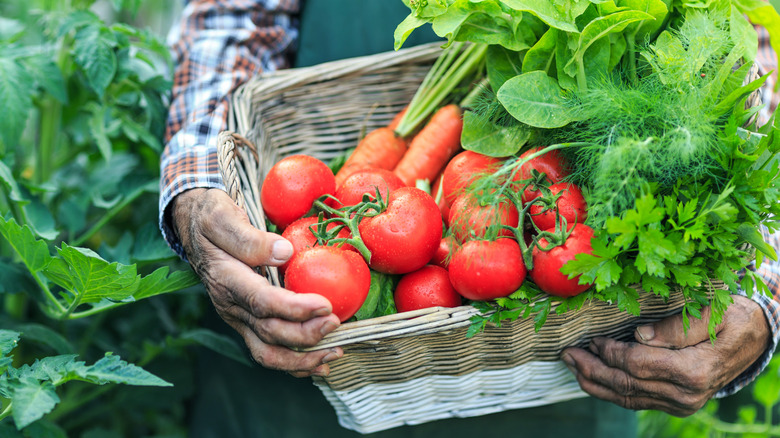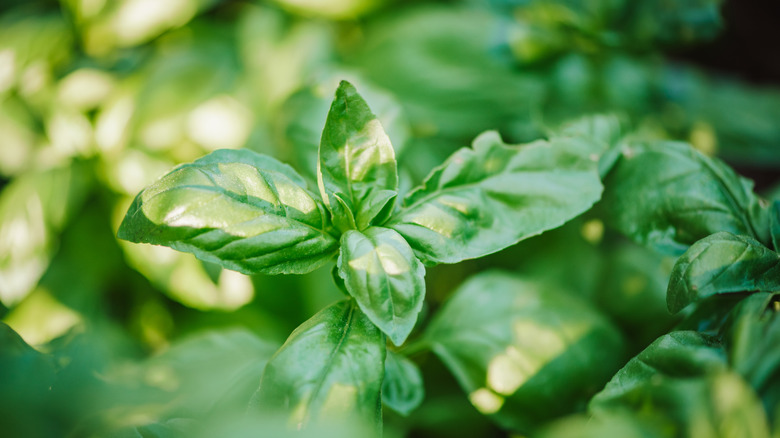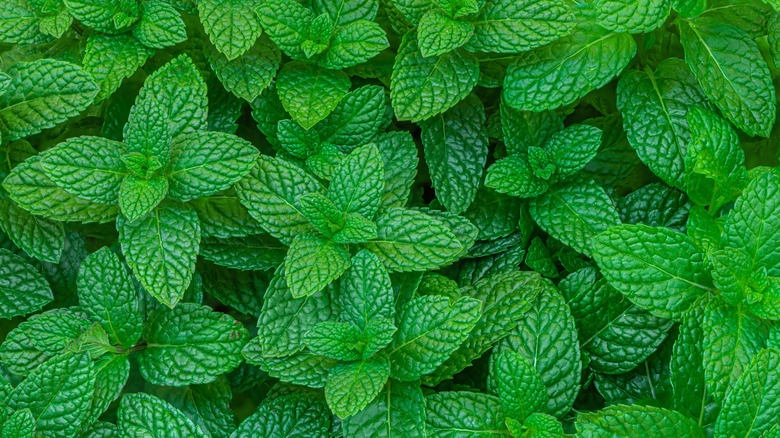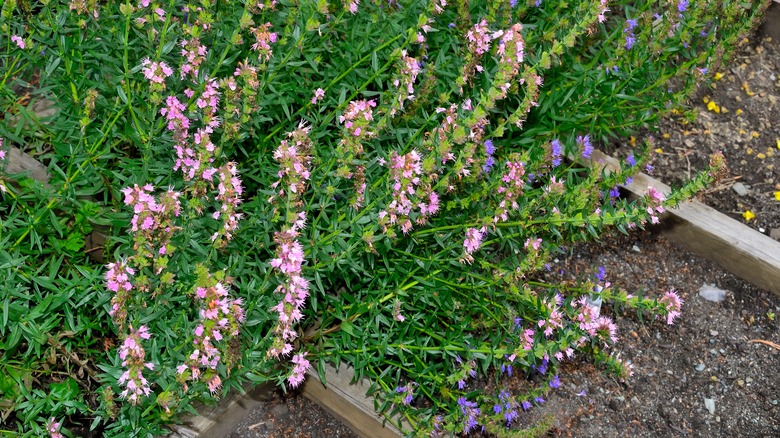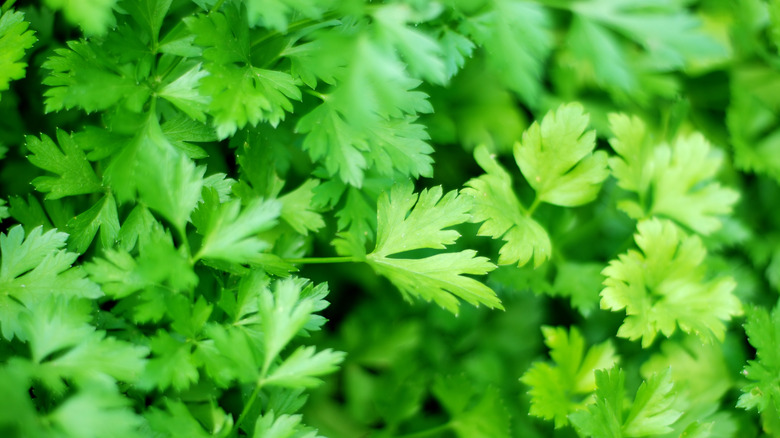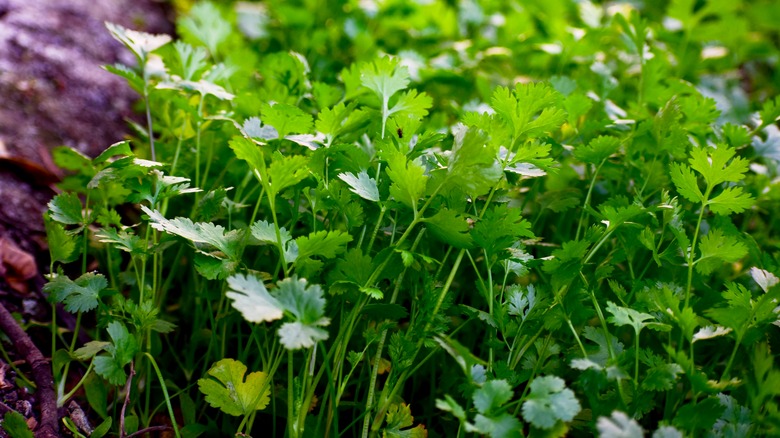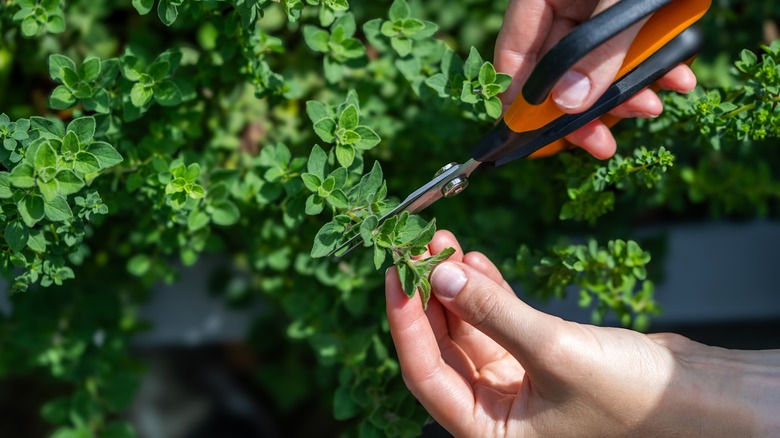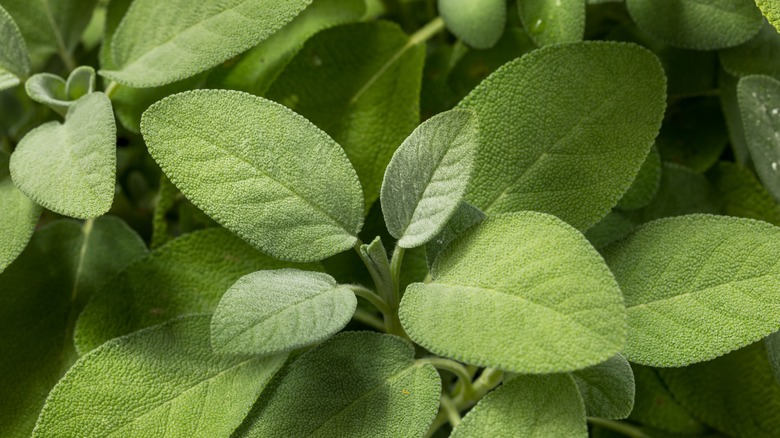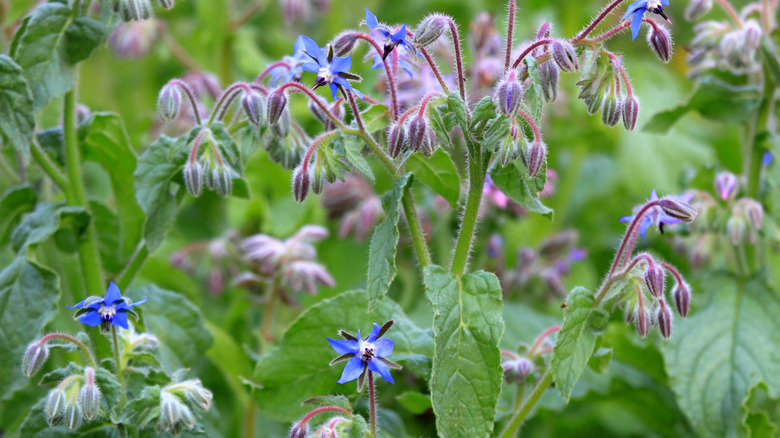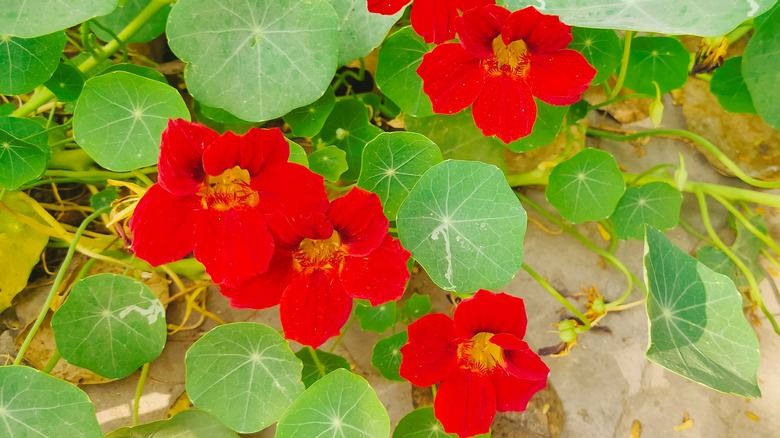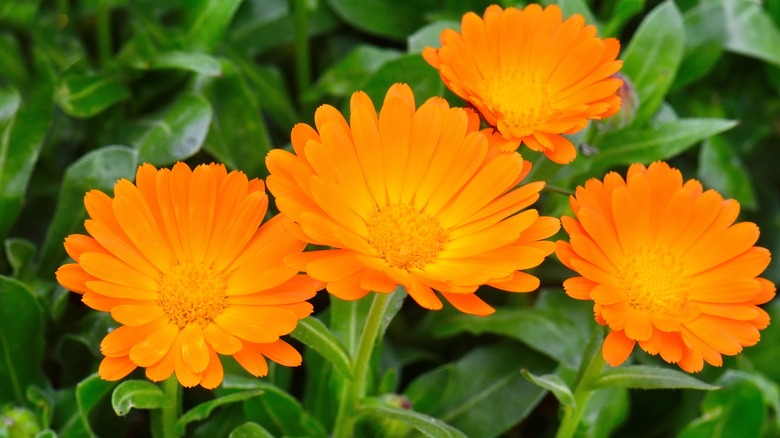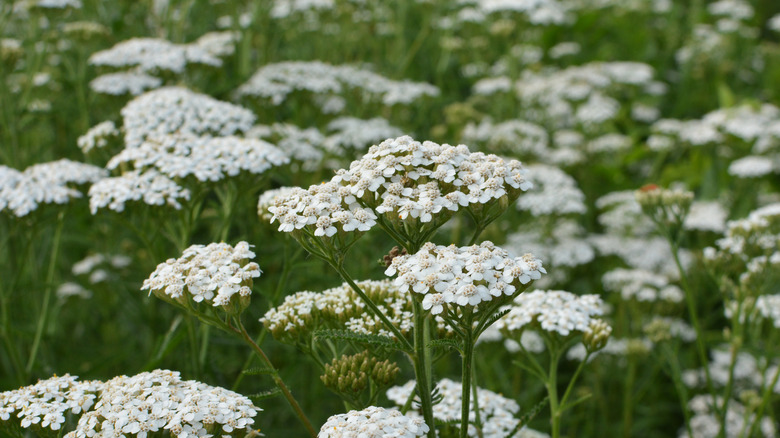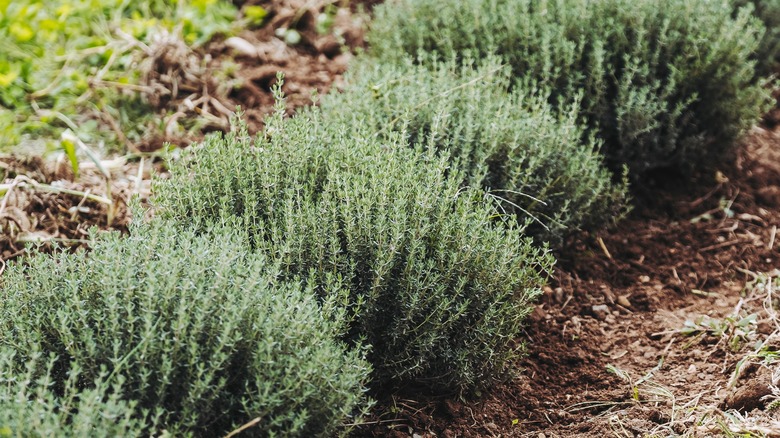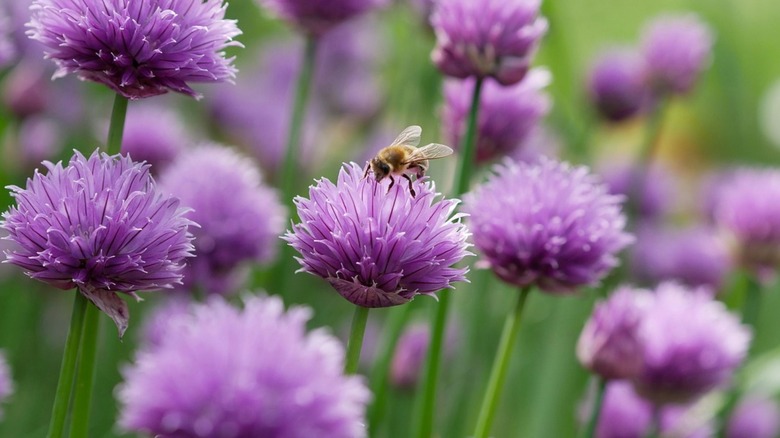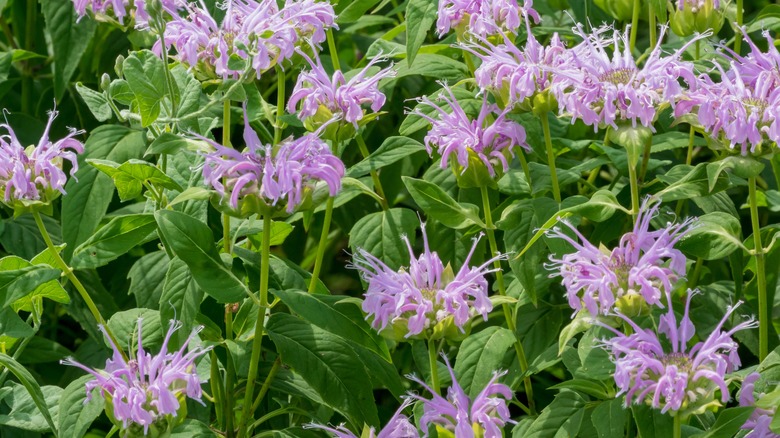14 Herbs You Should Be Growing Near Tomatoes In The Garden
Companion planting can do a lot for your garden and, though there is debate over its effectiveness, it often makes for a more diverse and interesting garden. And it's certainly a plus when you can pair plants with your tomatoes that can improve their health and even flavor. One of the biggest culinary wins in all of home gardening might be successful companion plantings between tomatoes and herbs, which can result in more flavor. We found 14 of these pairings (or many more if you split up groups like mint). From the ordinary couplings with basil and oregano to the less-traveled paths of yarrow, borage, and hyssop, these co-plantings can take you on quite a taste adventure, all the while making your tomatoes more productive.
As always, do your homework before intercropping tomatoes with anything in your garden. The vagaries of soil, climate, and interactions with other plants could take a particular plant from companion to enemy in no time. As you're working through it, also be wary of a handful of plants that you don't want too close to your tomatoes. But think through what problems you've had with tomatoes in the past, look for companion plants that might help, and then do a bit of research to make sure it's right for your garden.
1. Basil
As we'll see, most members of the mint family are beneficial to tomato plants. Basil and its pest-repelling varieties like cinnamon basil deserve special mention because it has been extensively studied as a tomato companion plant, and because tomato and basil is a classic culinary pairing. Intercropping with basil has been correlated to various improvements in tomatoes: higher yields and more marketable fruits, enhanced growth rates, higher amounts of antioxidant polyphenols, and maybe even improved wound response. But, perhaps most important, tomato and basil team up in a number of classic dishes and sauces.
2. Mint
Mints like peppermint and lemon balm are generally good partners for tomato plants, and have other benefits too. Mint improves crop yield and quality, discourages diseases in the soil, and manages the magic trick of repelling harmful insects while attracting pollinators and beneficial predatory insects like the tomato bug (Nesidiocoris tenuis). Mint has a downside, though: it grows so well that many varieties can get out of hand. Consider planting it in pots with your tomatoes, or between paved areas of your yard where its growth will be limited.
3. Hyssop
Hyssop is a shrub native to southern Europe, Asia, and Africa, and while it's a member of the mint family, it's an unusual plant in the U.S. and is different enough to consider separately. It has been studied alongside basil and peppermint and found to improve growth in tomatoes. Hyssop is a semi-evergreen perennial that is used to flavor food and provide fragrance to cosmetics. It's also commonly used as a folk remedy for a number of health issues, but there's not yet any conclusive scientific evidence to support its effectiveness.
4. Parsley
Parsley is widely used as a garnish, flavoring, cosmetic fragrance, and, though largely unsubstantiated, medicine. Its main contribution as a companion plant to tomatoes is its ability to attract beneficial insects, including hoverflies and especially ladybugs, which prey on aphids and the dreaded tomato hornworm. It has also been shown to repel harmful insects like some beetles, animals that might feed on your tomatoes, and perhaps small children who cannot yet tolerate any speck of green in their food (though they probably aren't yet voracious consumers of tomatoes either).
5. Cilantro and coriander
Cilantro, a type of parsley, is another storied culinary companion to tomatoes. What would salsa be without cilantro and tomatoes? And the beauty is that you can have more salsa because cilantro is great for tomato plants in a number of ways. It attracts beneficial insects, including predators and pollinators; reduces disease and attacks by pests; and improves the flavor of nearby tomatoes. The trick is to let your cilantro bolt –- produce flowers — rather than harvesting it all as an herb. In addition to the tomato benefits, you'll also get coriander, which are cilantro seeds.
6. Oregano and marjoram
You can't really talk about culinary herbs that pair well with tomatoes without bringing up oregano, a defining element of classic Italian tomato sauces. It attracts pollinators while discouraging both insect and animal pests. Oregano is a drought-tolerant plant used in xeriscaping, and as such prefers drier soil conditions than tomatoes, so it's best to grow in pots beside tomatoes so you can manage water needs separately. Oregano and marjoram are members of the same genus and have similar benefits when co-planted with tomato, but can have slightly different culinary uses.
7. Sage
These days, most people seem to know sage mostly as an ingredient in sausage or as a component of cleansing rituals. But it's also a beautiful and tasty herb that has some benefits when planted alongside tomatoes. It attracts pollinators and repels some harmful insects, especially tomato hornworm. Tomato hornworm will in turn attract predatory wasps that will eat them. Ramon Gonzalez, who's been blogging about gardening since 2005, prefers letting the wasps devour the pests instead of manually removing them because it encourages the wasps to remain present in the garden... as does growing sage.
8. Borage
You can be forgiven for not being familiar with borage, but if you're a tomato grower, that's about to change. There aren't many herbs that have as many benefits for tomato plants, including attracting beneficial predatory and pollinating insects (including a species of parasitic wasp that parasitizes aphids), deterring harmful insects, functioning as a living mulch, supplying trace minerals, and even reportedly improving the flavor of tomatoes. It has more general garden benefits, but be aware that it can cause contact dermatitis in some, so handle and harvest with gloves.
9. Nasturtiums
You might think of nasturtiums as a flower or as a source of pods that are an alternative to capers, but it's also an herb that's almost universally touted as a great companion plant for tomatoes. It repels some insect pests while attracting beneficial bugs, and it serves as a trap crop for aphid control. Put some space between nasturtiums and tomatoes though, because that will make it more effective at keeping aphids away and will keep the aggressively vining nasturtiums from getting into a wrestling match with your tomatoes over space and sunlight.
10. Calendula
Calendula, also known as pot marigold, is a beautiful flowering herb. Sometimes mistaken for proper marigolds, the low-maintenance calendula provides similar benefits for tomato plants. Its bright, nectar-rich flowers attract pollinators and beneficial insects while repelling common pests, including thrips, beetles, and dreaded tomato hornworms. It is also edible, and its vibrant petals can be used as a garnish in salads and other dishes. We've seen claims that calendulas repel rabbits, but they are often used as a treat for pet bunnies, so grow them cautiously if rabbits are an issue in your garden.
11. Yarrow
Yarrow was named the 2024 Herb of the Year by the International Herb Association. You might only be familiar with it as a flower or as a tea that is said to reduce inflammation and aid digestion, but yarrow is also an effective plant to interplant with tomatoes. Its main benefit is its ability to summon armies of predatory beneficial insects -– ladybugs, wasps, damselflies, and more -– that keep harmful bugs away, including tomato hornworms, aphids, and flea beetles. Yarrow is also an effective attractor of pollinators, including butterflies and bees.
12. Thyme
Thyme is a great plant to grow with your tomatoes, and it also happens to be both delicious and perennial, so it keeps providing benefits to your garden and kitchen long after your tomatoes' time has ended. This classic garden herb inhibits the reproduction of yellow-striped armyworms by reducing the number of eggs they lay. This might not help the moment you find an infestation, but as time goes by they should become less of a problem. Thyme is an effective living mulch, which is a lifesaver between waterings during dry periods.
13. Chives
It's not always clear whether some alliums or all alliums are considered herbs or vegetables, but chives are usually grouped with herbs by the typical gardener. This perennial in the onion family benefits tomatoes by repelling aphids and mites. Some have suggested that chives deter nematodes, but we couldn't find any evidence for that claim — in fact, chives might actually be a host plant for nematodes, so plant with caution. Chives are underappreciated as a flower, producing pretty little purple blooms that attract pollinators like butterflies, bees, and wasps.
14. Bee balm
Bee balm, as you may guess from the name, attracts pollinators, which is undoubtedly a plus for tomato growers. The name "bee balm" is used to refer to both wild bergamot and Monarda didyma, a plant that is sometimes referred to as simply bergamot. (More confusingly, none of these is actually the bergamot that provides flavor in your tea — that comes from a Mediterranean citrus tree.) Wild bergamot is said to improve the taste of tomatoes grown nearby. While we couldn't find studies to confirm that claim, bee balm is sure to make your garden pollinators happy.
